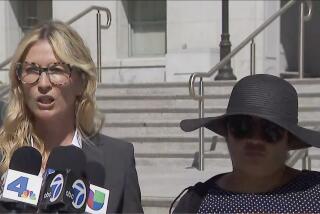Suspect Hurt in Police Chase Can Sue, Court Says
- Share via
SAN FRANCISCO — The California Supreme Court, ruling in a police negligence case, decided Monday that cities can be held liable when law enforcement officers injure a fleeing suspect during a car chase.
The conservative court’s 6-1 ruling, which surprised even the lawyers in the case, may prompt more lawsuits against cities for all kinds of injuries and damage that police inflict during vehicle pursuits. Previously, lower courts have been divided over whether cities were immune from damages in such cases.
“It will put the police departments of the entire state on notice that pursuits, and particularly pursuits of pedestrians, must be done with care and without violence,” said Beatrice Taines, a lawyer for the plaintiff in the case.
The decision stems from a negligence lawsuit filed by Pele Thomas, who became a quadriplegic at 18 when a police car hit him. Thomas and a friend were standing on a street corner in Richmond, a heavily African American, industrial, waterfront city near Berkeley, about 11:30 p.m. on Sept. 4, 1990.
An anonymous caller to police reported spotting two men with shotguns or rifles on that corner. When police pulled up only minutes later, Thomas and his friend ran, ignoring an officer’s commands to “Stop! Halt!”
Three police cars gave chase, and one of them plowed into Thomas as he ran across a street, breaking his back. The officers later said that they had not seen either suspect with a gun, and no weapons were found in the area.
Thomas, who had no criminal record, is now confined to a wheelchair. He said he ran because his friend bolted and because he had noticed the first officer on the scene sliding a billy club into his belt. Thomas said his father had once been beaten by Richmond police.
“I was just scared,” said Thomas, now 23.
A Superior Court judge dismissed his suit against Richmond, but the Court of Appeal in San Francisco overturned the ruling and decided that Thomas could take his suit to trial. The Supreme Court’s ruling affirmed that decision.
“It will lead to quite a few more cases going to the jury on pursuits involving police officers,” predicted Walnut Creek lawyer A. Byrne Conley, who represented the city of Richmond.
Conley said injuries occur “fairly often” during police pursuits, sometimes to third parties who happen onto the scene. The ramifications of the ruling could be limited in some situations by a state law that grants cities immunity if they adopt specific safeguards during pursuits. But the law has yet to be fully interpreted by courts, Conley said.
The majority court opinion, written by Justice Armand Arabian, represented a straightforward recitation of the laws on governmental immunity and the state vehicle code.
The court based its decision on a vehicle law that says public entities are liable for death or injury caused by a negligent act with a motor vehicle.
The court’s decision surprised the attorneys on both sides because they said the justices appeared inclined to sympathize with the city during a recent hearing. The Republican-dominated court generally supports law enforcement and tries to restrict lawsuits, but on occasion has allowed suits over police misconduct.
Justice Ronald M. George filed the sole dissent, arguing that Richmond was immune from damages under a state law that protects cities from suits over injuries caused by someone trying to resist arrest or detention.
“The collision . . . occurred late at night, within seconds after plaintiff ran into the street, at full speed, in the path of the patrol vehicle, attempting to evade capture,” George wrote. “Whether the police officer driving the patrol vehicle acted reasonably must be determined in light of the quickly changing, emergency circumstances encountered by the officer.”
Officer Jim Jenkins, who struck Thomas, said his foot slipped from the brake as he tried to avoid him. But the Court of Appeal found evidence of “intentional action,” said Taines, Thomas’ appellate lawyer.
Thomas lives alone in a Richmond apartment across the hall from a sister who cares for him. He said he is taking computer classes, using specially designed braces to hit the keys, and spends most of his time reading the Bible and riding BART. It is a lonely life, he said.
“Whenever I can, I go in my electric wheelchair here and there,” he said. “I love riding BART. Sometimes I get on that thing and ride to the last stop and look at the scenery and thank God for seeing another day.”
Thomas’ case can now go before a jury, which probably will be asked to assess the city’s responsibility for the injury. The city will argue that he was largely responsible because he fled into a public street.
More to Read
Sign up for Essential California
The most important California stories and recommendations in your inbox every morning.
You may occasionally receive promotional content from the Los Angeles Times.










